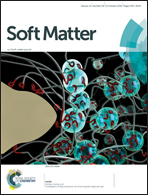Multi-stimuli-responsiveness of a novel polydiacetylene-based supramolecular gel†
Abstract
Herein, a novel supramolecular gel was fabricated through the bi-component co-assembly strategy of commercially available 10,12-pentacosadiynoic acid (PCDA) and laboratory-synthesized amphiphilic co-gelator N-(2-(1H-imidazol-4-yl)ethyl)stearamide (IMSA), which contains one imidazole head group and a long alkyl chain tail, by synergetic noncovalent interactions. Upon irradiation of normal 254 nm UV light, blue polydiacetylene (PDA) could be obtained by topo-polymerization of the PCDA monomers in the gel phase. This PDA-based supramolecular gel is able to respond to various environmental stimuli and shows a blue-to-red chromatic transition, which could be observed by the naked eye. Specifically, upon exposure to heat, pH, metal cation and organic solvent stimuli, the PDA gel displays thermochromism, halochromism, ionochromism and solvatochromism, respectively. More interestingly, the differences of the above-mentioned stimuli-induced color transition of the blue PDA supramolecular gels could be characterized by UV-Vis absorption spectra and Raman spectra, therefore illuminating a bright application prospect in the area of chemosensing.



 Please wait while we load your content...
Please wait while we load your content...